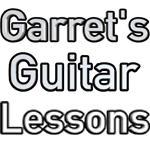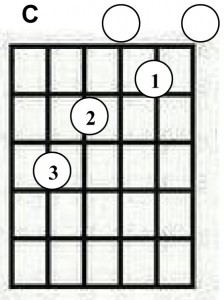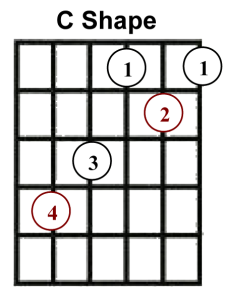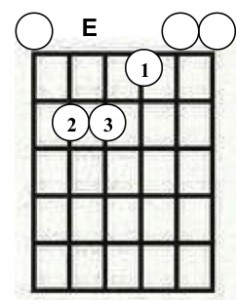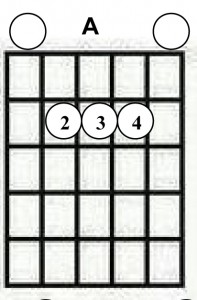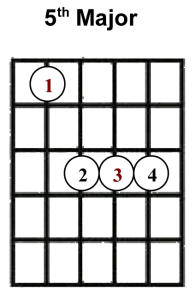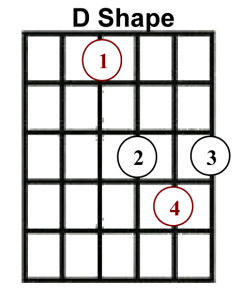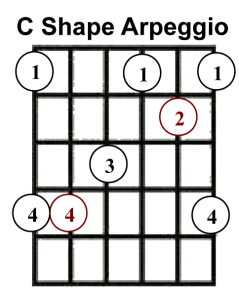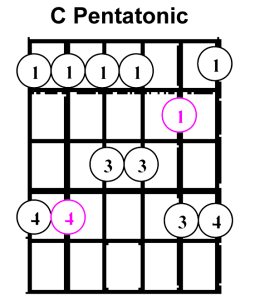The CAGED System is a tool that helps you visualize the fretboard. The idea of it is to take open chord shapes and base fretted chord shapes, arpeggio shapes and scale shapes around the open chord shapes. We connect them all by their roots notes in this order: C – A – G – E – D. So first I’m going to compare our open C Chord to our “C Shape” that we can move around the neck:
Our biggest challenge is to turn the open strings in our C open chord into a barre chord. This is where some of our odd fingerings come from. In our open position, we only have to fret notes that aren’t open, in our barre chord position we have to fret all of the notes. Our first finger acts as a “capo” to play the chord shapes along the neck. We’re probably most comfortable with this via our barre chords of E and A:
Perhaps you’ve noticed this before, but our 6th string barre chord is just our E chord with our first finger taking care of all of the open strings! Same with our A chord to our 5th string barre chords.
Where Do We Get the Word CAGED From?
It’s an acronym for the open chords we turn into “barre” chords. We have a version of our C open chord, A open chord, G open chord, E open chord and D open chord. Instead of playing open strings, has our first finger in it’s place. 5th string major = A shape, 6th string major = E shape. The red circles indicate the root note:
Why In That Order?
This is where it gets really cool. Each of those chords, in that order, connects to the one after it. Look for the “pivot” note, a note that stays the same throughout both shapes. Although the fingering may change, the note stays the same. Let’s take a look at how each one connects to the shape name to the right in CAGED:
C to A
Our 4th finger note on the 5th string in the “C shape”, is the same fret that we’d put our first finger on for our “A shape”.
Example: Let’s say we’re trying to play a D chord as a “C shape” then an “A shape”. I’d put my 4th finger on the 5th fret, 5th string (on the D note) and play my C shape. I’d then put my 1st finger on the 5th fret, 5th string (on the D note) and play my A shape.
Why Do You Keep Saying ‘Shape’?
It’s important to remember that the red circles are the root notes in our chord shape. So I keep saying shape because our chord looks like a C, but is really the chord name that the red note is on. The shape just refers to how we choose to play that chord. Much like how you can play D as an open chord, 5th string barre chord or 6th string barre chord. These CAGED shapes are to give you more options for playing the chord and have a chord shape for each part of the neck.
Alright, so now that’s out of the way, let’s continue with connecting between our shapes:
A to G
My A shape has a red note on the 3rd string and so does my G shape. That’s going to be our pivot note. So our 3rd finger note on the 3rd string in the “A shape”, is the same fret that we’d put our first finger on for our “G shape”.
Example: Let’s say we’re trying to play a D chord as an “A shape” and an “G shape”. I’d put my 3rd finger on the 7th fret, 3rd string (on the D note) and play my A shape. I’d then put my 1st finger on the 7th fret, 3rd string (on the D note) and play my G shape.
G to E shapes
My G shape has a red note on the 6th string and so does my E shape. That’s going to be our pivot note. So our 4th finger note on the 6th string in the “G shape”, is the same fret that we’d put our first finger on for our “E shape”.
Example: Let’s say we’re trying to play a D chord as an “G shape” and an “E shape”. I’d put my 4th finger on the 10th fret, 6th string (on the D note) and play my G shape. I’d then put my 1st finger on the 10th fret, 6th string (on the D note) and play my E shape.
E to D shapes
My E shape has a red note on the 4th string and so does my D shape. That’s going to be our pivot note. So our 4th finger note on the 4th string in the “E shape”, is the same fret that we’d put our first finger on for our “D shape”.
Example: Let’s say we’re trying to play a D chord as an “E shape” and a “D shape”. I’d put my 4th finger on the 12th fret, 4th string (on the D note) and play my E shape. I’d then put my 1st finger on the 12th fret, 4th string (on the D note) and play my D shape.
D to C shapes
This ones very important, it completes our cycle and starts us back where we started. With our root notes consistently being D, this ones pretty high up there, but with other root notes it’ll be perfectly comfortable.
My D shape has a red note on the 2nd string and so does my C shape. That’s going to be our pivot note. So our 4th finger note on the 2nd string in the “D shape”, is the same fret that we’d put our 2nd finger on for our “C shape”.
Example: Let’s say we’re trying to play a D chord as a “D shape” and a “C shape”. I’d put my 4th finger on the 15th fret, 2nd string (on the D note) and play my D shape. I’d then put my 2nd finger on the 15th fret, 2nd string (on the D note) and play my C shape.
What About Other Root Notes?
My example of D was great, but what about playing through the CAGED shapes through B or Ab?! Start from the lowest shape you can and run through the chords that way.
In the example of B, the lowest shape we can play is an A shape with the root note on the 5th string, 2nd fret. Then run through the CAGED order only starting on A – AGEDC.
In the example of Ab, the lowest shape we can play is a G shape with the root note on the 6th string, 4th fret. Run through the CAGED order only starting at G – GEDCA
How to practice – Pick a chord a day, C – F – Bb – Eb – Ab – Db – F# – B – E – A – D – G and run through the CAGED chords up and down the neck, starting from the lowest shape you can play.
How Will This Help Me Learn Arpeggios and Scales?
We now have a reference point that we can tether our arpeggios and scales to. Once we can visualize these chord shapes everywhere, all we have to do next is fill other notes in between and around our basic chord ‘shape’. Take a look at my C shape followed by some other C ‘shape’ scale and arpeggios:
Notice how everything has the same roots? In the C shape Scale I outline the chord shape itself.
How About Minor Chords?
Minor chords, arpeggios, scales all work the same way, only now their minor. Once you feel comfortable with the CAGED chord major shapes, give the minor shapes a try!
What Does ‘Alt’ Mean On Your PDF’s?
I also have 2 different versions of our “E shape” arpeggios and scales and 2 different versions of our “A shape” arpeggios and scales. No alt means I put my first finger on the root note and have my arpeggios/scales go higher up the fretboard. “Alts”, as I call them, mean I put my second finger on my root note and have my arpeggios move above and behind the root note a little bit. It’s more of a thoroughness thing. You can choose one that’s more comfortable for you or practice both.
I call them “Alts” because it’s short for ‘alternates’. There is no right way or wrong way, only many ways.
This is one way to visualize the fretboard, not the only way or the right way. It’s all a matter of preference. This is one of the easiest ways to work through fretboard in my opinion. Some may feel boxed in this way, which I understand. CAGED shapes and Horizontal or Single String Scales are the two that I stress. If you can see scales/arpeggios/chords both vertically and horizontally then the boxes just all blend together.
Now that you understand what makes CAGED work so well give these videos a try!
- Major CAGED Chord Shapes
- Minor CAGED Chord Shapes
- Major CAGED Arpeggio Shapes
- Minor CAGED Arpeggio Shapes
- Major CAGED Pentatonic Scale Shapes
- Minor CAGED Pentatonic Scale Shapes
- Major CAGED Scale Shapes
- Minor CAGED Scale Shapes
- How to Practice and Apply CAGED Shapes
